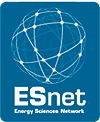North American collaboration partners

CANARIE
Established in 1993 CANARIE is Canada's Advanced Research and Innovation Network. CANARIE connects over 40,000 researchers at 125 Canadian universities, 132 colleges and 49 general and vocational colleges, as well as scientists at many research institutes, hospitals, and government laboratories throughout Canada. Schools and cultural institutions also benefit from the connectivity provided by CANARIE.
CANARIE is a member of the DICE Collaboration.
IP connectivity to CANARIE is provided by the 10-Gbps link between Amsterdam and New York link. Dedicated circuits to Canada can be carried on the two 10-Gbps links between Paris and New York and London and New York respectively.
To learn more about CANARIE, visit the CANARIE website
ESnet
 ESnet is the Energy Sciences Network in the United States which serves Department of Energy scientists at over 40 institutions, enabling researchers to collaborate on projects including energy, climate science, and the origins of the universe. ESnet is funded by the US Department of Energy Office of Science, and managed and operated by the ESnet team at Lawrence Berkeley National Laboratory. ESnet is the Energy Sciences Network in the United States which serves Department of Energy scientists at over 40 institutions, enabling researchers to collaborate on projects including energy, climate science, and the origins of the universe. ESnet is funded by the US Department of Energy Office of Science, and managed and operated by the ESnet team at Lawrence Berkeley National Laboratory.
ESnet is a member of the DICE Collaboration.
IP connectivity to ESnet is provided by the 10-Gbps links between Amsterdam and New York and Frankfurt and Washington DC. The Vienna-New York link provides an additional 5 Gbps of capacity between GÉANT and ESnet. Dedicated circuits to ESnet are carried on the two 10-Gbps links between Paris and New York and London and New York respectively.
To learn more about ESnet, visit the ESnet website

Internet2
Launched in 1996, Internet2 is a not-for-profit advanced networking consortium comprising more than 200 U.S. universities in cooperation with 70 leading corporations, 45 government agencies, laboratories and other institutions of higher learning. User groups who benefit from the connectivity provided by Internet2 include science and engineering, health, education and the arts and humanities.
The CEO and President of Internet2 is Dave Lambert who replaced outgoing CEO and President, Douglas Van Houweling on 13th July 2010.
Internet2 is a member of the DICE Collaboration.
IP connectivity to Internet2 is provided by the 10-Gbps links between Amsterdam and New York, and Frankfurt and Washington DC. Capacity for dedicated circuits to Internet2 is provided by the two 10-Gbps links between Paris and New York and London and New York respectively.
To learn more about Internet2, visit the Internet2 website

National LambdaRail (NLR)
Founded in 2003, National LambdaRail (NLR) is a high-speed, optic fibre network infrastructure which covers 12,000 miles and connects over 280 universities, private and U.S. government laboratories and advanced programs across the United States.
IP connectivity to NLR is provided by the 10-Gbps links between Amsterdam and New York.
To learn more about National LambdaRail, visit the NLR website.
NASA Integrated Services Network (NISN)
The NASA Integrated Services Network (NISN) provides connectivity for all NASA enterprises, programmes and centres.
IP connectivity to NISN is provided by the 10-Gbps link between Frankfurt and Washington DC.
To learn more, visit the NISN website

USLHCNet
USLHCNet is a wide-area network which supports the Large Hadron Collider at CERN in Geneva, Switzerland, and the High Energy Physics (HEP) community in the United States. Funded by the US Department of Energy and CERN, USLHCNet is managed by the California Institute of Technology (CALTECH) in collaboration with CERN.
USLHCNet operates a series of 10-Gbps links interconnecting CERN, MANLAN in New York and Starlight in Chicago and provides reliable, high-bandwidth connectivity between CERN and Tier1 sites. Together with GÉANT, ESnet, Internet2 and the US National Science Foundation’s UltraLight project, USLHCNet also supports connectivity between US Tier1 and European Tier2 centres as well as between European Tier1 and US Tier2 centres.
Among USLHCNet’s transatlantic links is one which lands at SARA. Onward connectivity to CERN is provided by a 10-Gbps GÉANT Lambda circuit. USLHCNet also funds the 5-Gbps link from Vienna to
New York which provides connectivity between GÉANT and ESnet.
USLHCNet is a member of the DICE Collaboration.
To learn more about USLHCNet, visit the USLHCNet website.
Return to previous page |